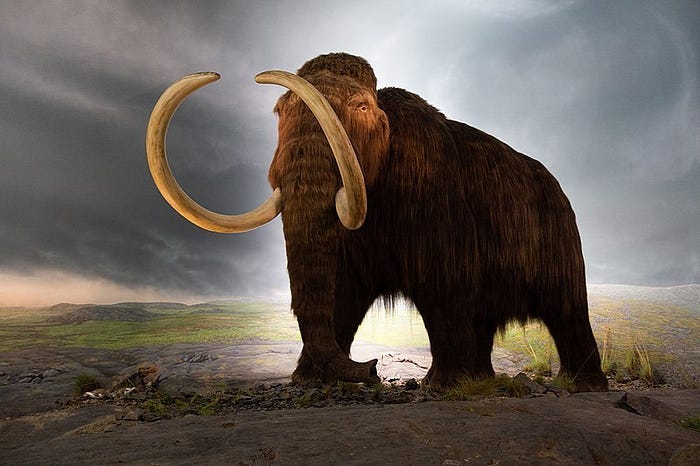The Last Stand of the Woolly Mammoth
The Ice Age giant's tragic end on Wrangel Island

Four thousand years ago, when the Pharaohs built the magnificent pyramids at Giza, the last surviving woolly mammoth died on Wrangel Island. Roughly the size of Crete, the island is in the Arctic Ocean, near the Russia-U.S. border. The majestic creature had lost its sense of smell, shrunk in size, and its iconic hair no longer kept it warm.
Plagued by diabetes and infertility, the mammoth breathed its last.
A once mighty species was no more.
You may wonder how the beast, believed to be extinct by the end of the Last Ice Age ( around 10,500 years ago), survived so long. Though the mammoth vanished in most of Eurasia and North America by then, there were a few holdouts. Wrangel Island was the ultimate one.
What brought them to a remote island far away from the rest of the world? Why was the mammoth’s extinction so tragic?
These questions intrigued me, and I wanted to know more about the creature’s final days. Thanks to advances in genetic studies, we have answers. But before discussing the creature’s last stand on Wrangel Island, let’s review its evolutionary history to see how the woolly mammoth became synonymous with the Ice Age.
The Rise and Fall of the Woolly Mammoth

The woolly mammoth is the most studied extinct megafauna. Unlike dinosaurs, we have an exact idea of its appearance. Our ancestors lived among the mammals and drew them on cave walls.
Several mammoth skeletons and mummies preserved in permafrost (in Siberia, Alaska, and Canada) support the authenticity of the drawings. We’ve found the creature with intact eyeballs, hair, and tusks. Thousands of bodies are still undisturbed, frozen in the permafrost.
According to paleontologist Steve Brusatte, as the permafrost thaws, mammoths “fall out like walnuts in a puddle of melting Rocky Road ice cream.”
Woolly mammoths were the size of modern African elephants. Males were about 3 meters (10 feet) tall and weighed up to 8 tons. Females were slightly smaller, measuring 2.5–2.9 meters (8.5–9.5 feet) and weighing about six tons. Surprisingly, the closest living relative of the mammoth is the Asian elephant, not the African elephant.
The woolly mammoth (Mammuthus primigenius) roamed the earth 800,000 years ago after branching out from the steppe mammoth (Mammuthus trogontherii) until its extinction 4,000 years ago. To better understand their final days, we must know how woolly mammoths evolved to survive the Ice Age.
As the name implies, the woolly mammoth’s most distinguishing feature is its hair. They have two layers of fur. The outer hairs, each up to three feet long, formed a cloak, and the inner layer was a shorter and fluffier undercoat. The hair secreted fluids to repel ice and water, insulating the creature. Contrary to popular belief, mammoth hair came in various colors, including blond, orange, brown, black, and bicolor.
How do we know this?
The history of this Ice Age giant is written in its genes. Thanks to the well-preserved mummies, mammoth DNA has been widely researched. It may sound shocking, but we know more about mammoth DNA than the DNA of most living mammals.

Genetics reveals a fascinating story.
Scientists identified the genes responsible for the mammoth’s tiny ears and tail (relative to elephants). They’ve also pinpointed the genes associated with their plush fur, gigantic sebaceous glands, and increased body fat. Mammoths could withstand lengthy, dark winters thanks to mutations that altered their circadian rhythm. Elevated hemoglobin levels allowed them to carry more oxygen in frigid conditions.
Why are we discussing this?
As we’ll see in the next section, the evolutionary features that made the mammoth the undisputed king of the Ice Age became less prominent, and the last surviving creatures were a pale shadow of their mighty ancestors.
Why was the mammoth confined to a tiny island in the Arctic Ocean?
What happened to the creatures that roamed over Eurasia and North America?
Unlock this exclusive post by becoming a paid subscriber. As a special offer for being part of our history-loving community, enjoy 15% OFF on annual subscriptions FOREVER. This is a limited-time discount and only valid till April 15th!
Keep reading with a 7-day free trial
Subscribe to Forgotten Footprints to keep reading this post and get 7 days of free access to the full post archives.

